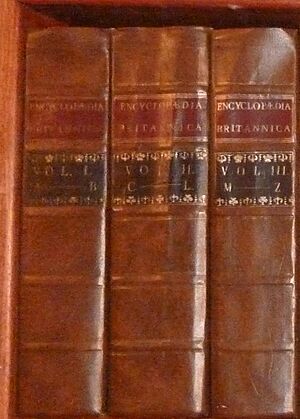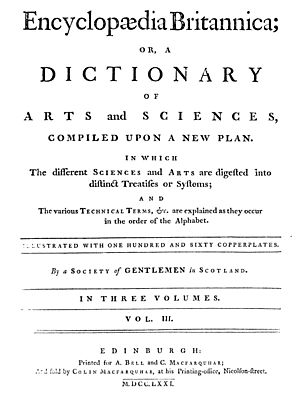Encyclopædia Britannica First Edition facts for kids
The Encyclopædia Britannica First Edition was a huge set of books published a long time ago, between 1768 and 1771. It was the very first version of the famous Encyclopædia Britannica. Two friends, Colin Macfarquhar and Andrew Bell, started it in Edinburgh, Scotland. They sold it piece by piece over three years. Most of the articles were written by William Smellie. Andrew Bell drew all the pictures.
Contents
How the First Edition Was Made
The idea for the Britannica came from Colin Macfarquhar, who sold and printed books, and Andrew Bell, who made engravings. Both lived in Edinburgh. They wanted to create a new encyclopedia that was different from the French Encyclopédie by Denis Diderot. The French version was seen by some as having ideas that went against common beliefs of the time.
Starting a New Encyclopedia
The French Encyclopédie had actually started as a French version of an English encyclopedia called Cyclopaedia. That book was published by Ephraim Chambers in 1728. Even though Chambers' book was still popular, Macfarquhar and Bell felt it was time for something new. They were inspired by the exciting new ideas happening in Scotland at the time, known as the Scottish Enlightenment.
Choosing an Editor
Macfarquhar and Bell needed someone to write and organize the encyclopedia. They chose William Smellie, a smart 28-year-old. He was paid 200 pounds sterling to create the encyclopedia. It was planned to be released in 100 parts, like thick magazines, which were later put together into three large books.
First Release and Sales
The very first part came out on December 10, 1768, in Edinburgh. It cost sixpence, or eight pence for a fancier paper version. The Britannica was published under a secret name: "A Society of Gentlemen in Scotland". This name probably referred to the many people who bought subscriptions. By releasing parts every week, the Britannica was finished in 1771. It had 2,391 pages in total.
The Three Volumes
The parts were bound into three books of about the same size. They covered topics from "Aa" to "Bzo," "Caaba" to "Lythrum," and "Macao" to "Zyglophyllum." About 3,000 sets of the first edition were sold. Each full set cost 12 pounds sterling.
Pictures and What Happened to Some of Them
The First Edition had 160 pictures. These were copperplate illustrations made by Bell. Some of these pictures were quite detailed. For example, there were three pages showing parts of the female body and babies in the article about childbirth. King George III saw these pictures and ordered them to be removed from every copy of the encyclopedia.
A New Way to Organize Information
What made the Britannica special was how it put related topics together. Instead of just listing every single word in alphabetical order, it grouped similar subjects into longer articles. These longer articles were then arranged alphabetically.
Why This New Plan Was Better
Older English encyclopedias often listed terms separately, like a dictionary. The people behind the Britannica thought this way of organizing "tore apart the sciences." Smellie believed their new plan made the Encyclopaedia Britannica much better for learning about arts and sciences than any other book published before. This idea for a "new plan" is often credited to Colin Macfarquhar, though Smellie also said it was his own idea.
Who Wrote It and What They Used
Smellie wrote most of the first edition himself. He borrowed ideas and information from many famous writers of his time. These included people like Voltaire, Benjamin Franklin, Alexander Pope, and Samuel Johnson.




